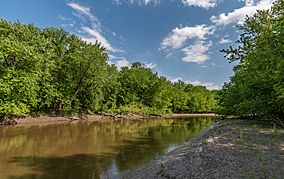Pike Island facts for kids
Quick facts for kids Pike Island |
|
|---|---|
| Wita Tanka | |
|
IUCN Category III (Natural Monument)
|
|

Pike Island, 2018
|
|
| Location | Saint Paul, Minnesota, United States |
| Area | 210 acres (85 ha) |
| Elevation | 699 ft (213 m) |
| Designation | Fort Snelling State Park |
| Named for | Zebulon Pike |
| Governing body | Minnesota Department of Natural Resources |
| Website | Fort Snelling State Park |
Pike Island (called Wita Tanka in the Dakota language) is an island in the state of Minnesota, USA. It is located where the Mississippi River and Minnesota River meet, in the southwestern part of Saint Paul.
This island is part of Fort Snelling State Park. It is also within the Mississippi National River and Recreation Area. For many years, the Dakota people have seen this island as a very special and sacred place. They used to move here with the seasons to find food and other important things. The island is named after Zebulon Pike. He helped the United States government buy this land from the Mdewakanton Sioux Indians in 1805.
Contents
A Special Place for the Dakota People
For hundreds of years, the Dakota people have considered the area where the Mississippi and Minnesota rivers meet to be a sacred place. They call it Bdote, which means "where two waters come together." They believed that this area, especially the two bluffs, was where the first Dakota man and woman came into being. It was a place of creation for them.
How Pike Island Got Its Name
In September 1805, a large area of land, including Pike Island, was bought from the Mdewakanton Sioux Indians. This purchase was made by Zebulon Pike. The land Pike helped buy later became important places like Fort Snelling, Minneapolis, and Saint Paul.
The U.S. government wanted to build a fort there. This fort would help protect American interests in the fur trade in the region. Pike was the one who worked out the agreement for this land. He thought the land was worth a lot of money. However, the U.S. Senate later agreed to pay a much smaller amount.
Early Settlers and Conflicts
In 1819, Colonel Henry Leavenworth invited Jean-Baptiste Faribault and his family to live on Pike Island. Faribault was a French Canadian who helped with the fur trade. In 1820, a special agreement gave ownership of Pike Island to Elizabeth Pelagie Ferribault. She was a Dakota Indian and Jean-Baptiste Faribault's wife.
Later, in 1862, there was a conflict known as the Dakota War of 1862. After this war, many Dakota people faced difficult times. More than 1600 Dakota women, children, and older men were held on Pike Island. They were kept under the watchful eyes of Fort Snelling.
Life on the island during that winter was very hard. There was little food and no proper shelter. Many people became sick, and hundreds died. In May 1863, the survivors were forced to leave on steamboats. They were moved to a new place called Crow Creek in the Dakota Territory. This new home was suffering from a severe lack of rain. Three years later, the remaining survivors were moved again to the Santee Sioux Reservation in Nebraska.
Fun Things to Do on Pike Island
Pike Island is a great place for outdoor activities. It is part of Fort Snelling State Park and the Mississippi National River and Recreation Area.
Hiking and Exploring
There is a hiking trail on Pike Island that is about 3.7-mile (6.0 km) long. This trail is made of natural ground and goes around the outside of the island. It leads to the spot where the Minnesota and Mississippi rivers meet, and there's a sandy beach there.
Winter Activities
In the winter, when there's snow, the main trail is prepared for cross-country skiing. This makes it a fun place to ski.
Fishing Spots
You can also find several smaller dirt trails that branch off the main path. These trails lead to the banks of the two rivers. They give you easy access if you want to go fishing.
Images for kids
-
Fort Snelling and Pike Island, 1850
See also
 In Spanish: Isla Pike para niños
In Spanish: Isla Pike para niños



